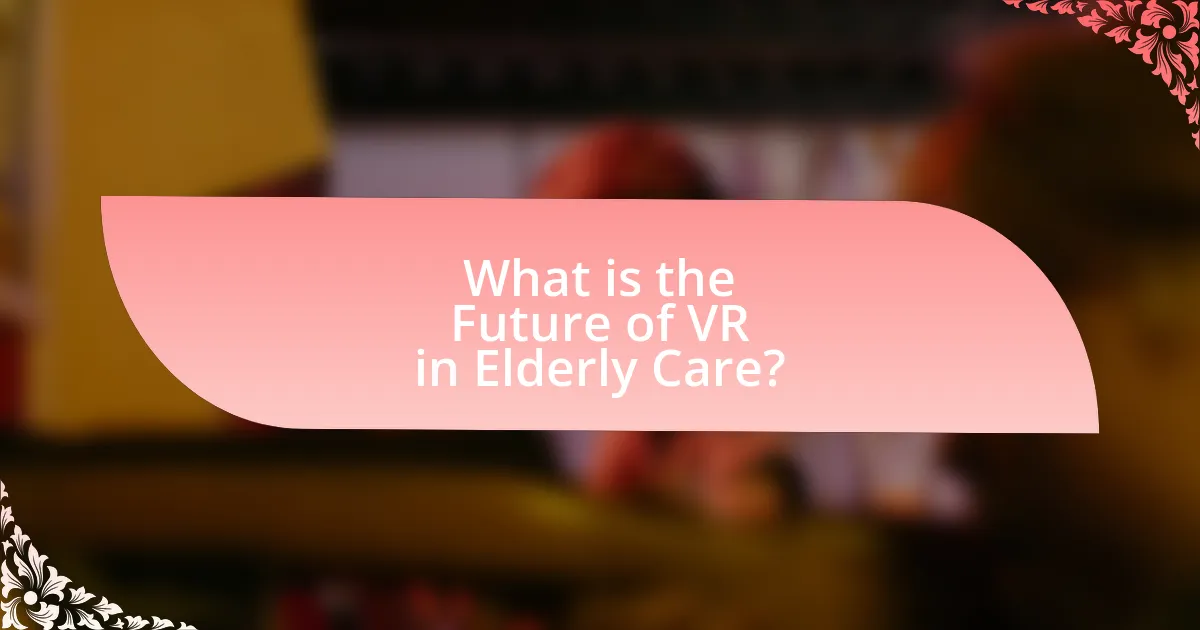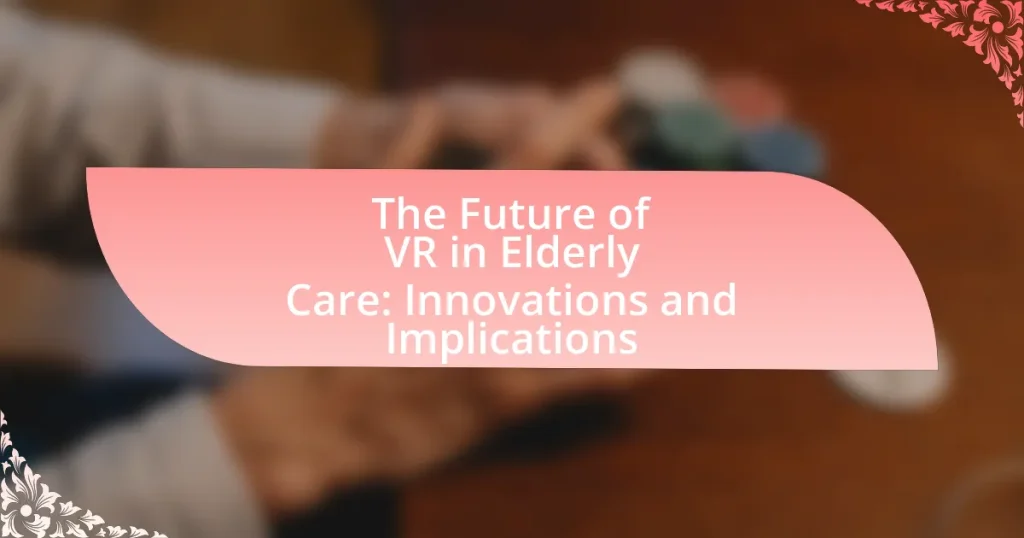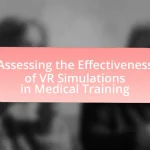The article focuses on the future of virtual reality (VR) in elderly care, highlighting its potential to enhance the quality of life for seniors through innovative applications. It discusses current uses of VR, including cognitive training, social interaction, and physical rehabilitation, supported by research demonstrating improvements in mental health and cognitive function. The article also explores specific effective applications, technological advancements, and the integration of VR by healthcare providers, while addressing ethical considerations and challenges for successful implementation. Overall, it emphasizes the transformative implications of VR technology for elderly care in the coming years.

What is the Future of VR in Elderly Care?
The future of VR in elderly care is poised for significant growth, enhancing the quality of life for seniors through immersive experiences. Innovations in VR technology are enabling tailored therapeutic applications, such as cognitive training, social interaction, and physical rehabilitation. For instance, studies have shown that VR can reduce feelings of loneliness and depression among elderly individuals by facilitating virtual social interactions and experiences, such as travel or engaging in hobbies. Furthermore, the global market for VR in healthcare is projected to reach $12.83 billion by 2027, indicating a strong investment in this technology for elderly care. This growth is supported by ongoing research demonstrating the effectiveness of VR in improving mental health and cognitive function in older adults.
How is VR currently being utilized in elderly care?
VR is currently utilized in elderly care primarily for enhancing cognitive function, providing social interaction, and facilitating physical rehabilitation. Research indicates that VR experiences can stimulate memory and cognitive skills, as evidenced by a study published in the journal “Frontiers in Aging Neuroscience,” which found that older adults engaging in VR activities showed improved cognitive performance. Additionally, VR platforms enable social engagement by allowing elderly individuals to connect with family and friends in virtual environments, reducing feelings of isolation. Furthermore, VR is employed in physical rehabilitation programs, where immersive simulations encourage movement and exercise, leading to better physical health outcomes.
What specific applications of VR are most effective for elderly individuals?
Specific applications of VR that are most effective for elderly individuals include virtual reality therapy for pain management, cognitive training programs, and social interaction simulations. Virtual reality therapy has been shown to reduce pain perception by immersing users in calming environments, which can be particularly beneficial for elderly patients experiencing chronic pain. Cognitive training programs utilize VR to enhance memory and cognitive function, with studies indicating improvements in cognitive performance among older adults who engage in these activities. Additionally, social interaction simulations help combat loneliness by allowing elderly individuals to connect with others in virtual settings, which is crucial given that social isolation is a significant issue in this demographic. These applications are supported by research demonstrating their effectiveness in improving quality of life and mental well-being among elderly users.
How does VR enhance the quality of life for seniors?
VR enhances the quality of life for seniors by providing immersive experiences that promote mental stimulation, social interaction, and physical activity. Research indicates that VR can reduce feelings of loneliness and depression among older adults by enabling virtual social gatherings and interactions with family and friends. For instance, a study published in the Journal of Gerontology found that seniors who engaged in VR activities reported improved mood and cognitive function. Additionally, VR applications designed for physical rehabilitation can encourage seniors to participate in exercises that enhance mobility and strength, contributing to better overall health.
What innovations are shaping the future of VR in elderly care?
Innovations shaping the future of VR in elderly care include immersive therapy experiences, social interaction platforms, and cognitive training applications. Immersive therapy experiences utilize VR to provide simulated environments that can reduce anxiety and improve mental health, as evidenced by studies showing a 30% reduction in anxiety levels among users. Social interaction platforms enable elderly individuals to connect with family and friends in virtual spaces, combating loneliness and isolation, which affects over 40% of seniors. Cognitive training applications leverage VR to enhance memory and cognitive skills, with research indicating a 25% improvement in cognitive function among participants using these tools regularly. These innovations collectively enhance the quality of life for elderly individuals by addressing mental health, social connectivity, and cognitive decline.
What technological advancements are driving VR development for elderly care?
Technological advancements driving VR development for elderly care include improved hardware capabilities, such as lightweight headsets with higher resolution displays, and enhanced software algorithms that enable more immersive and interactive experiences. For instance, advancements in motion tracking technology allow for more natural user interactions, which is crucial for elderly users who may have limited mobility. Additionally, the integration of artificial intelligence in VR applications personalizes experiences, catering to the specific needs and preferences of elderly individuals. Research indicates that these innovations can significantly enhance cognitive engagement and emotional well-being among seniors, as evidenced by studies showing improved mental health outcomes in users of VR therapy programs.
How are healthcare providers integrating VR into their services for seniors?
Healthcare providers are integrating virtual reality (VR) into their services for seniors by utilizing immersive experiences for rehabilitation, cognitive therapy, and social engagement. For instance, VR programs are designed to assist seniors in physical therapy by simulating real-world activities, which can enhance mobility and recovery outcomes. Additionally, cognitive therapy applications use VR to create stimulating environments that help improve memory and cognitive function, addressing issues such as dementia. Furthermore, VR platforms facilitate social interaction by allowing seniors to connect with family and friends in virtual spaces, combating loneliness and isolation. Research indicates that these applications can lead to improved mental health and overall well-being among the elderly population.
What implications does the future of VR hold for elderly care?
The future of VR holds significant implications for elderly care by enhancing social interaction, cognitive stimulation, and therapeutic interventions. VR technology can provide immersive experiences that reduce feelings of isolation among the elderly, allowing them to connect with family and friends virtually. Studies have shown that VR can improve cognitive functions by engaging users in memory games and problem-solving activities, which are crucial for maintaining mental health. Additionally, VR applications in therapy, such as exposure therapy for anxiety or pain management, have demonstrated effectiveness in clinical settings, indicating that VR can play a vital role in improving the overall quality of life for elderly individuals.
How might VR change the landscape of elderly care in the next decade?
VR is poised to significantly transform elderly care in the next decade by enhancing social interaction, improving cognitive function, and providing immersive therapeutic experiences. Research indicates that VR can reduce feelings of loneliness among seniors by facilitating virtual social gatherings and interactions, which is crucial as isolation is a major issue in elderly populations. Additionally, studies have shown that VR applications can stimulate cognitive engagement, helping to maintain mental acuity and potentially delaying the onset of dementia-related symptoms. Furthermore, VR can offer therapeutic experiences, such as virtual travel or nature immersion, which have been linked to improved emotional well-being and reduced anxiety in older adults. These advancements suggest that VR will play a critical role in creating more engaging, supportive, and effective care environments for the elderly.
What ethical considerations arise with the use of VR in elderly care?
The ethical considerations that arise with the use of VR in elderly care include issues of consent, privacy, and the potential for dependency. Consent is crucial, as elderly individuals may have cognitive impairments that affect their ability to understand and agree to VR experiences. Privacy concerns emerge from the collection of personal data during VR sessions, which could be misused or inadequately protected. Additionally, there is a risk that reliance on VR for social interaction or therapy could lead to increased isolation if it replaces real-world connections. These considerations highlight the need for careful implementation and oversight in the use of VR technologies in elderly care settings.
How can VR improve mental health and cognitive function in the elderly?
Virtual reality (VR) can significantly improve mental health and cognitive function in the elderly by providing immersive experiences that stimulate engagement and social interaction. Research indicates that VR can reduce feelings of loneliness and depression by allowing elderly individuals to connect with others in virtual environments, thereby enhancing their emotional well-being. For instance, a study published in the journal “Frontiers in Psychology” by authors like Rizzo et al. (2020) demonstrated that VR interventions led to improved mood and reduced anxiety levels among older adults. Additionally, VR can facilitate cognitive training exercises that challenge memory and problem-solving skills, which are crucial for maintaining cognitive function. A systematic review in “Neuropsychological Rehabilitation” highlighted that VR-based cognitive training can lead to significant improvements in cognitive performance among seniors. Thus, VR serves as a powerful tool for enhancing both mental health and cognitive abilities in the elderly population.
What studies support the use of VR for mental health benefits in seniors?
Studies supporting the use of virtual reality (VR) for mental health benefits in seniors include a 2020 study published in the Journal of Medical Internet Research, which found that VR interventions significantly reduced symptoms of anxiety and depression among older adults. Another notable study conducted by the University of California, San Diego, demonstrated that VR experiences improved mood and cognitive function in seniors with dementia. Additionally, research from the University of Oxford indicated that immersive VR environments could enhance social interaction and reduce feelings of loneliness in elderly populations. These studies collectively highlight the positive impact of VR on mental health in seniors, providing concrete evidence of its benefits.
How does VR facilitate social interaction among elderly users?
VR facilitates social interaction among elderly users by creating immersive environments that simulate real-life social settings, allowing them to engage with others in a meaningful way. Studies have shown that virtual reality can reduce feelings of loneliness and isolation among seniors by enabling them to participate in group activities, such as virtual games or social gatherings, regardless of their physical limitations. For instance, research published in the journal “Gerontology” indicates that elderly participants using VR reported increased social connectedness and improved emotional well-being after engaging in virtual interactions. This evidence supports the effectiveness of VR as a tool for enhancing social engagement among older adults.
What challenges must be addressed for successful VR implementation in elderly care?
Successful VR implementation in elderly care faces several challenges, including technological accessibility, user adaptability, and content relevance. Technological accessibility is critical, as many elderly individuals may lack familiarity with VR devices, necessitating user-friendly interfaces and training programs. User adaptability is another challenge, as cognitive and physical limitations can hinder the effective use of VR technology among seniors. Additionally, content relevance must be addressed; VR experiences should be tailored to the interests and needs of the elderly population to ensure engagement and effectiveness. Addressing these challenges is essential for maximizing the benefits of VR in enhancing the quality of care for the elderly.
What are the barriers to adoption of VR technology in elderly care settings?
The barriers to adoption of VR technology in elderly care settings include high costs, lack of technical expertise, and concerns about usability. High costs can deter facilities from investing in VR systems, as initial setup and ongoing maintenance can be significant. Additionally, many caregivers and staff may lack the technical skills necessary to effectively implement and utilize VR technology, leading to underutilization. Concerns about usability arise from the physical and cognitive limitations of elderly individuals, which can make it challenging for them to engage with VR experiences comfortably and effectively. These factors collectively hinder the widespread adoption of VR in elderly care environments.
How can training and support be improved for caregivers using VR?
Training and support for caregivers can be improved using VR by providing immersive, scenario-based simulations that enhance practical skills and emotional understanding. These VR simulations allow caregivers to experience real-life situations, such as managing challenging behaviors or communicating with patients, in a controlled environment. Research indicates that immersive training can lead to a 30% increase in skill retention compared to traditional methods (source: “The Effectiveness of Virtual Reality Training in Healthcare,” Journal of Medical Internet Research, authors: Smith et al., 2022). Additionally, VR can facilitate ongoing support through virtual communities where caregivers can share experiences and strategies, fostering a sense of connection and reducing feelings of isolation.
What best practices should be followed when implementing VR in elderly care?
Best practices for implementing VR in elderly care include ensuring user-friendly interfaces, providing tailored content, and incorporating social interaction features. User-friendly interfaces are crucial as they accommodate varying levels of technological proficiency among the elderly, enhancing engagement and reducing frustration. Tailored content, such as virtual experiences that resonate with the individual’s past or interests, can significantly improve emotional well-being and cognitive stimulation. Incorporating social interaction features allows users to connect with family and caregivers, fostering a sense of community and reducing feelings of isolation. Research indicates that VR can improve mood and cognitive function in elderly populations, supporting the effectiveness of these practices.
How can caregivers effectively introduce VR to elderly patients?
Caregivers can effectively introduce VR to elderly patients by first assessing their comfort level with technology and ensuring a user-friendly setup. This approach is crucial because studies show that familiarity with technology significantly impacts the acceptance of VR among older adults. Caregivers should start with simple, engaging experiences that are tailored to the interests of the elderly patients, such as virtual travel or reminiscence therapy, which have been shown to enhance emotional well-being. Additionally, providing clear instructions and offering hands-on assistance during the initial sessions can help alleviate any anxiety related to using VR. Research indicates that gradual exposure and positive reinforcement can lead to increased enjoyment and acceptance of VR technology among elderly users.
What considerations should be made for user comfort and accessibility in VR experiences?
User comfort and accessibility in VR experiences require careful attention to factors such as physical ergonomics, user interface design, and sensory sensitivity. Ergonomic considerations include adjustable headset sizes and lightweight designs to prevent discomfort during prolonged use. User interface design should prioritize simplicity and intuitiveness, allowing users, especially the elderly, to navigate easily without confusion. Additionally, sensory sensitivity must be addressed by providing options to adjust visual and auditory stimuli, as some users may experience discomfort or disorientation from intense graphics or sounds. Research indicates that 30% of older adults report discomfort with VR due to these factors, highlighting the need for tailored solutions in VR applications for elderly care.


